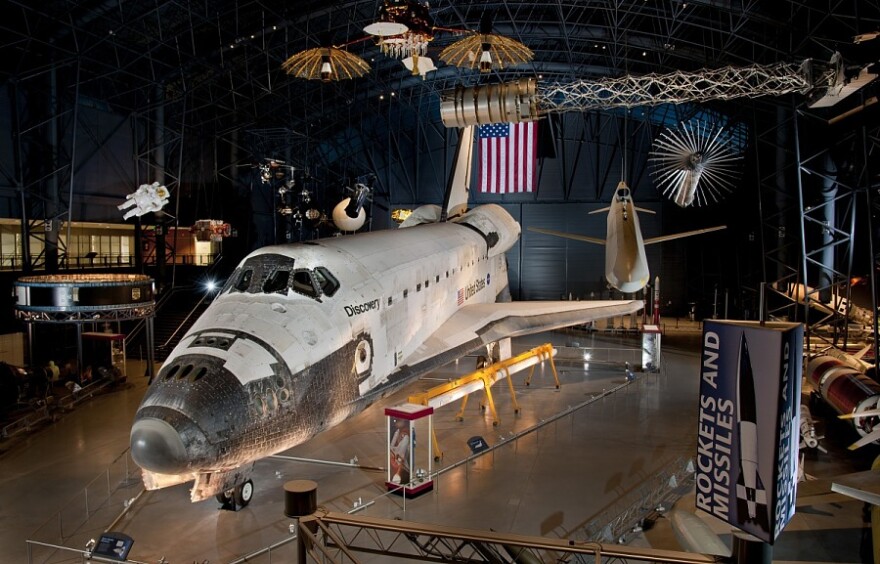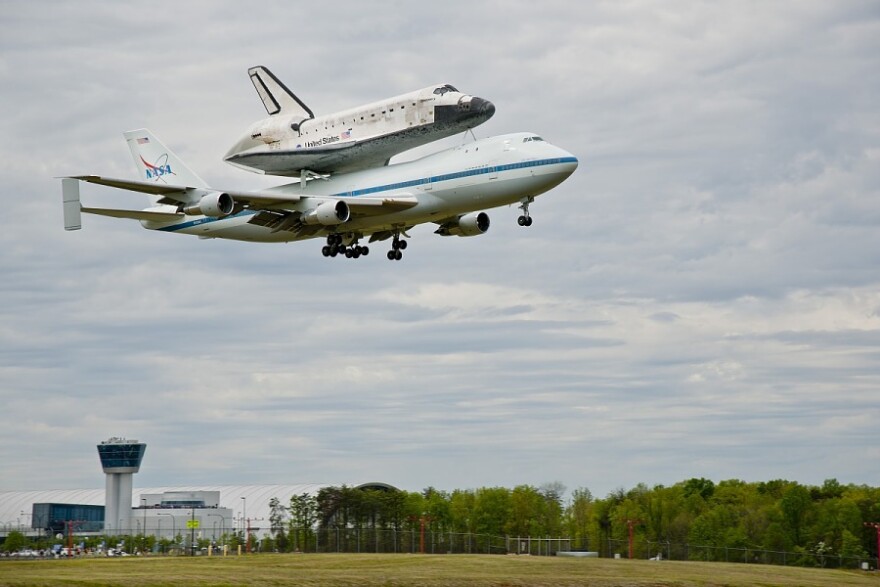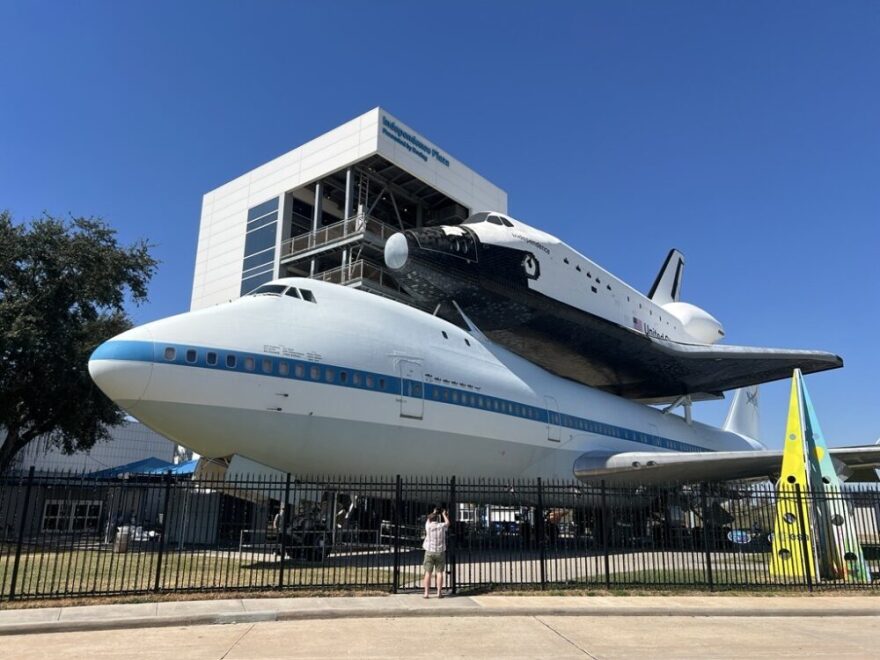
On paper, it reads like a riddle: How do you transport a 120-foot, 80-ton rocket from Washington to Houston?
One piece at a time, cutting the rocket up into parts, according to the Smithsonian and NASA.
In a letter sent to members of Congress, the national museum and the federal space agency estimate that the "minimal" cost estimate to relocate space shuttle Discovery to Houston is in the ballpark of $120-150 million, nearly double what the U.S. government set aside to move the shuttle while approving a broader tax and spending bill in July. On top of that, the space shuttle would likely have to be taken apart.

"While an engineering study will be necessary due to the size and weight of the space vehicle, both NASA and the Smithsonian believe that Discovery will have to undergo significant disassembly to be moved," the memo reads, according to sources with firsthand knowledge. "Discovery is the most intact shuttle orbiter of the NASA program, and we remain concerned that disassembling the vehicle will destroy its historical value."
U.S. Senators Ted Cruz and John Cornyn, the Texas Republicans who helmed the initiative to bring the space shuttle to Houston, have disputed that claim, calling it "misinformation about both the cost and logistics of the move." They've now called for a Department of Justice investigation into the Smithsonian, accusing the museum of illegal lobbying.
The dispute has drawn concerns and criticisms from some preservationists, space officials and grassroots advocates, including "Keep The Shuttle," an advocacy group urging the government reverse course.
"There's a significant risk, not only that the nation's premier aerospace institution could lose a critical part of its collection, but that this artifact could literally be ripped to pieces in the process," said Joseph Stief, founder of Keep The Shuttle.

What is the Discovery?
For nearly four decades, NASA launched a series of rockets— Enterprise, Columbia, Challenger, Discovery, Atlantis and Endeavour — known as space shuttles. Beginning in 1984, Discovery flew in 39 missions, totaling 365 days in space before its last mission in 2011.
The idea behind the space shuttle program was to build a rocket that could be used and reused over and over again on frequent trips to space. In order to do that, engineers needed to develop a method of insulating the space shuttles up to 7,000 degrees Fahrenheit, so they could withstand the heat from friction of entering and exiting the Earth's atmosphere.
The answer was a thermal protection system, or TPS: a barrier of reinforced panels, heat resistant glass-coated silica tiles, additional white silica tiles, and woven silica blankets, according to the Smithsonian.

The tiles, in particular, are revered as an innovation of space technology. Thousands of tiles cover each of the space shuttles: As many as 23,000 black, glossy tiles cover the entire underside and other parts of the shuttle where temperatures reach up to 2,300 degrees, while roughly 7,000 white tiles cover areas on the sides and upper surface where temperatures reach the relatively cooler 1,200 degrees.
"It's cutting-edge technology," said Dr. Olga Bannova, a professor at the University of Houston who researches space architecture. "Without it, the shuttle program wouldn't happen, right? It wouldn't be successful. So, it's an absolutely critical component."
John Kennedy McCoy previously worked as a technician on those tiles that protected Discovery. He said he was "like a little kid" when he first worked on the shuttle.
"I really was just awestruck the first time I saw it," McCoy said. "Because the ionized atmosphere, it actually left a pattern on the bottom of the tiles. It was ominous-looking, and you could tell that they go through a lot on descent and reentry."
Today, the Discovery rests at the Smithsonian's National Air and Space Museum, where it was brought in 2012, its innovative black tiles clearly visible. And it's those tiles that experts say are at risk of being destroyed if the space shuttle is moved to Houston.
Moving to Houston
By the time the space shuttle program wound down in 2011, the fleet of shuttles had been reduced to four; Challenger had exploded during liftoff in 1986, and Columbia broke up on reentry in 2003. Add to that, the original space shuttle, Enterprise, which had only orbited the Earth and not flown into space, had been taken apart and used for the construction of Endeavour. That left only three fully operational space shuttles: Discovery, Atlantis and Endeavour.

In 2010, Congress passed a law, signed by former President Barack Obama, that created a path for each of the remaining space shuttles to be distributed: an application process that prioritized displaying the space shuttles for the public in cities "with an historical relationship with either the launch, flight operations, or processing of the Space Shuttle orbiters or the retrieval of NASA manned space vehicles, or significant contributions to human space flight."
Enterprise, which had been at the Smithsonian, moved to the Intrepid Museum in New York City. Atlantis went to the Kennedy Space Center in Florida. Endeavour went to the California Space Center. Discovery was moved to the Smithsonian's Steven F. Udvar-Hazy Center, where it has been for the last 13 years.
In April, the two Senators from Texas filed a bill that would move Discovery to Houston, calling it the shuttle’s "rightful home." Cruz and Cornyn, the latter of whom faces a heated reelection bid in 2026, accused the Obama Administration and Sen. Chuck Schumer, D-New York, of exerting political pressure to select the recipients of space shuttles.
"Houston played a critical role throughout the life of the space shuttle program, but it is clear political favors trumped common sense and fairness when the Obama administration blocked the Space City from receiving the recognition it deserves," Cornyn said in an April news release. "I am proud to lead the effort to finally bring Discovery home to Houston, where future generations of Texans and Americans can come to learn about the city's integral role in our nation's space shuttle program."
Discovery doesn't have obvious ties to the Houston community, but its astronauts lived and trained in Houston.

The bill ultimately failed, but its central contents were revived in the Trump administration's “One Big Beautiful Bill Act,” which was signed into law in July. Within that legislation is an $85 million allocation to relocate the space shuttle.
Soon after it passed, Stief launched Keep The Shuttle, which has hundreds of followers on X and Facebook. Its logo emulates the historic "come and take it" flag from the Battle of Gonzalez, the first major battle of the Texas Revolution, albeit with the silhouette of a space shuttle rather than a cannon.
"That was when I saying to folks, ‘OK, I'm going to do something about this,'" Stief said. "This is not something that should be allowed to happen, and there needs to be a push back."
Taking the shuttle apart
In August, Secretary of Transportation Sean Duffy, who is also acting as NASA Administrator, approved Discovery to be moved to a nonprofit near the Johnson Space Center, likely Space Center Houston. The White House's Office of Management and Budget directed the Smithsonian and NASA to come up with a cost estimate for transportation, "including a description of the condition of the orbiter upon delivery," according to a spokesperson from the Smithsonian.
That's when the Smithsonian sent its letter to members of Congress, saying the rocket needed to be dismantled in order to be transported. Officials Houston Public Media spoke with said doing so would do potentially irreparable damage to the tiles on Discovery.
"It will cease to be a spacecraft, and, well, they'll turn it into a circus exhibit, if you're going to patch it back together with duct tape and baling wire," McCoy said.

Some Democrats are pushing back. Senators Mark Warner and Tim Kaine, both from Virginia, Dick Durbin of Illinois and Mark Kelly of Arizona — the latter of whom is a former astronaut who has flown the Discovery — called for the Senate Appropriations Committee to block the federal funding from going toward relocating the space shuttle.
In an interview, Warner criticized the relocation line item in the “One Big Beautiful Bill Act” as "something that says ‘let's take this national asset away from the Smithsonian, where it's exhibited for Americans to see for free, and move it to some facility in Texas where visitors will have to pay some steep admission fee.'"
In their own letter to the Senate Appropriations Committee, Cornyn and Cruz urged the committee not to subvert spending on the transportation of Discovery to Houston. They also accuse the Smithsonian of "actively work[ing] to block this legislation," including lobbying members of Congress, which they label as illegal.
"As part of its opposition effort, the Smithsonian has disseminated misinformation about the logistics of the move, falsely claiming that the shuttle's wings would need to be removed for transport, a claim not supported by industry experts," the letter, signed by Cruz and Cornyn, reads.
In October, the two senators went even further and called for a Department of Justice investigation into the Smithsonian Institution for illegally lobbying members of Congress to prevent the Discovery’s relocation.

In a statement, a spokesperson for the Smithsonian said, "The Smithsonian Institution owns the Space Shuttle Orbiter Discovery and holds it and all of its collections in trust for the nation. The Smithsonian has a unique responsibility to properly manage, preserve, and make accessible the collections in its care for current and future generations to appreciate, enjoy, and study. The Smithsonian carries out its stewardship responsibilities through systematic collections management policies, procedures, and plans based on professional and discipline-specific best practices."
In the past, shuttle transportation was largely handled by air — two Boeing 747s, specifically. The NASA 905 and NASA 911 were both used to carry space shuttles on top of them, ferrying space shuttles from landing sites back to the Kennedy Space Center. Both of those planes, though, have been retired. One of the planes, 905, is at the Space Center Houston.

In an interview with Houston Public Media, Keesha Bullock, the interim COO and chief marketing and communications officer at Space Center Houston, said the center follows Smithsonian guidelines on preservation. Whether or not the space shuttle is taken apart, she said, is out of their hands.
"Those decisions rest with Smithsonian and NASA's engineering teams," Bullock said. "Whatever the method, you know, we know that it would be handled under strict conservation protocols, and our focus here at Space Center Houston is to be ready with the facility and the environment and the expertise to receive Discovery safely."
But, as a line item in a broader spending bill, the movement of the space shuttle is technically the law of the land. Democrats and activists are calling on the Senate Appropriations Committee to step in and block Discovery from going on one final ride.
Copyright 2025 Houston Public Media News 88.7

